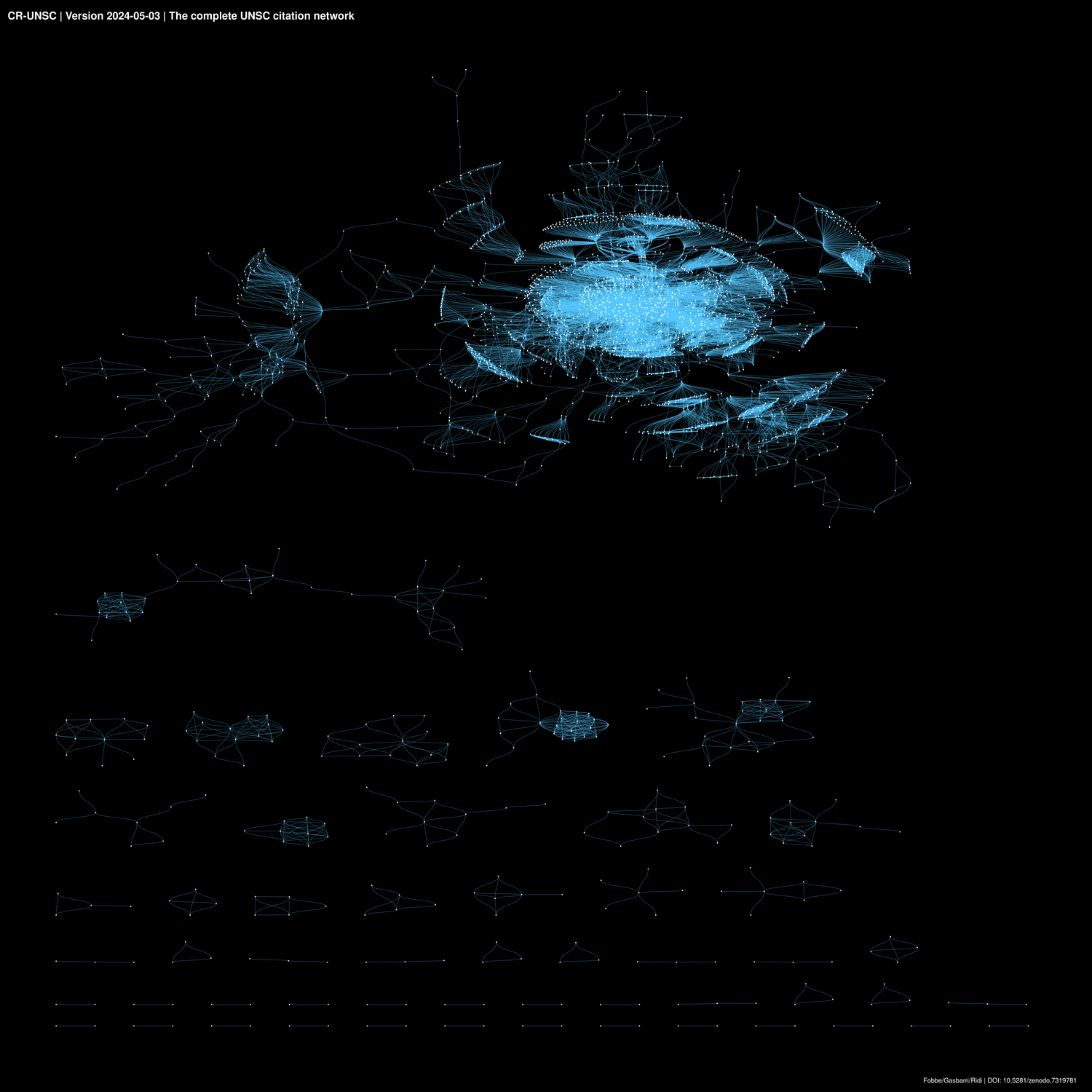- [Open Access] UN Security Council Citation Network Data (GraphML Format) (Zenodo 2024)
- [Open Access] Corpus of Resolutions: UN Security Council (CR-UNSC) (Zenodo 2024)
- [Open Access] Source Code for the ‘Corpus of Resolutions: UN Security Council’ (Zenodo 2024)
UN Security Council Citation Network Data Link to heading
The complete internal citation network of the UN Security Council (UNSC) up to resolution 2722 (1946–2023) with 54 metadata variables is now Open Access and available for download!
It is part of the Corpus of Resolutions: UN Security Council (CR-UNSC)1
The citation practice of the UN Security Council is special for a number of reasons. First, the text of every UNSC resolution undergoes intense diplomatic negotiations and every word, phrasing and citation is there for a reason. Second, citations to previous resolutions follow a clear, structured and easy-to-extract format. Third, they structure the practice of the UN Security Council into a web of context that is necessary to understand the impact and consequences of individual resolutions.
My colleagues Niccolò Ridi (King’s College London) and Lorenzo Gasbarri (Scuola Superiore Sant’Anna) have published a long and very interesting paper on these questions and the added value that citation analysis can bring to the study of the UNSC:
Ridi, Niccolo, & Gasbarri, Lorenzo. (2023). The role of previous resolutions in the practice of the security council. Columbia Journal of Transnational Law, 61(3), 571-640.
How to use the Citation Data Link to heading
There are many good network analysis packages for widely used data science programming languages such as R or Python. My favorites for R are {igraph} for analysis and {ggraph} for visualization. You might also like {tidygraph} or {qgraph} .
Igraph is also available for Python.
No Code? No Problem! You can use the citation data without coding skills and with a graphical user interface (GUI) via Gephi. Simply create a new project, open the GraphML file and off you go!2
Visual Representation of the UNSC Citation Network Link to heading

A visual representation of the UN Security Council internal citation network up to resolution 2722. It was created with {ggraph} and a high-resolution version of the image is published in the ‘analysis’ ZIP archive released with the CR-UNSC.
Technical Information on Citation Data Link to heading
The citations were extracted automatically with regular expressions from the English text of the resolutions. Resolutions 1 through 899, 902, 1445 and 1454 are expert-reviewed OCR text and all other resolutions from 900 to 2722 are extracted from born-digital PDF files.
The citation data is published in the widely used GraphML format, distributed within a ZIP archive.
UNSC resolution nodes are associated with as much metadata as makes sense from a network perspective. 54 variables from the main data set are included.
Note that the GraphML file does not contain the full texts of the resolutions to save space.
The main dataset in tabular form is a better choice natural language processing (NLP) tasks. If you wish to combine NLP and citation analysis I suggest you use both in your workflow: the main dataset to select the approriate node set(s), then pass these on to the citation analysis component.
About the Dataset Link to heading
The Corpus of Resolutions: UN Security Council (CR-UNSC) collects and presents for the first time in human and machine-readable form all resolutions, drafts, and meeting records of the UN Security Council, including detailed metadata, as published by the UN Digital Library and revised by ourselves.
The current version collects resolutions 1 (1946) through 2722 (2024) in all six official UN languages (English, French, Spanish, Arabic, Chinese, Russian), with drafts and meeting records in English and a massive number of features.
See this blog post introducing the dataset for an overview of the dataset and its functionality.
-
Resolution 2722 was adopted in 2024, but I the citation network is complete up to 2023. I mention 2023 here to avoid the impression that the citation network also fully covers 2024. ↩︎
-
While I do strongly recommend approaching quantitative projects with an open source programming language, release of the source code and reproducible analyses. However, there are a good number of use cases where non-programmers can enhance their own research with network data and the assistance of graphical programs. Following chains of precedent is an important one in legal work. ↩︎